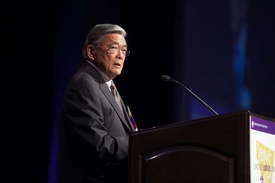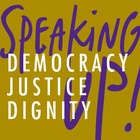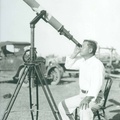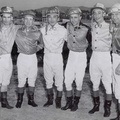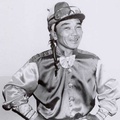If you have not taken in a Japanese American National Museum (JANM) event, be it a workshop, book reading, or some other special program, I highly recommend that you do so. The National Museum knows how to put on a good show, and everything is always meticulously planned down to the last detail. JANM’s 2013 National Conference “Speaking Up! Democracy, Justice, Dignity” held at the Sheraton Seattle Hotel, July 4 through 7, 2013, was no exception.
Some five hundred of us from across the country converged on the “Emerald City” to commemorate the 25th anniversary of the signing of the Civil Liberties Act of 1988. The conference was a meaningful experience from beginning to end.
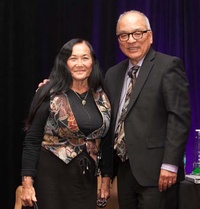
Jeanne Wakatsuki Houston and Moderator Frank Abe at Screening and Discussion of "Farewell to Manzanar" (Photo courtesy of Tracy Kumono Photography)
The first day started with a bus tour of the International District that introduced us to Seattle’s past. On the last day we took a ferry to Bainbridge Island to see how the Nikkei experience is playing out in the present and what it means for the future of the island, which, by the way, was first to be issued exclusion orders under Executive Order 9066. As my friend Dr. Art Hansen astutely observed, the two tours were perfect bookends for all that took place in between: emotional breakout sessions; a luncheon and banquet with distinguished speakers who provoked thought, challenged, and inspired us; and a screening of Farewell to Manzanar with an appearance by Jeanne Wakatsuki Houston.
As more and more time goes by, it becomes more and more important for us to be reminded how the Civil Liberties Act of 1988 was achieved and that many determined individuals and organizations in different parts of the country initiated and carried out the movement, which evolved during a nearly twenty-year struggle before it culminated in the realization of an official presidential apology and reparations. I felt pretty well versed on the subject before the conference—but I was wrong.
Sessions on the power of the commission hearings, what it meant to look like the enemy, the significance of the Tule Lake Segregation Center, and the poignancy of the voices from the Justice Department internment camps were eye-opening. I learned so much from the firsthand accounts shared by the Nisei who lived through the war years and from the Nisei and sansei who took part in the redress movement in the 1980s. As I look back to those early days of the movement, I would like to think that I did my part in my very small way. I remember that the first time I ever gave a speech was for my eighth-grade civics class public-speaking contest sponsored by the Westmorland Lions Club in 1981. The topic that I selected for my speech was the newly formed Commission on Wartime Relocation and Internment of Civilians. My mother remarked that it was a brave choice given the area that we live in.
But at the same time, the purpose of the conference was not to get “mired in the past” as keynote speaker and former Secretary of Transportation Norman Mineta emphasized, but to reaffirm that we are “invested in our future.” He declared that “failing to treat people on the basis of their own merits is a constant human failing…and those of us who know the consequences of that, must remain ever vigilant, not vigilantes, but be vigilant in the protection of our Constitutional rights.”
(Watch The Honorable Norman Y. Mineta - Keynote Address >>)
I can also report to you that I got to meet JANM’s new President and CEO, Greg Kimura, Ph.D., albeit briefly. I told him how grateful I am to the National Museum for being so supportive of the Japanese American Gallery in the past, and Dr. Kimura gave his assurance that he intends to continue to support our Imperial Valley Nikkei history project.
There is a Japanese proverb: I no naka no kawazu, taikai o shirazu, meaning “A frog in the well knows nothing of the great ocean.” Since the Imperial Valley is so inaka (far out in the boondocks), it is easy to become like that frog in the well. As of late, I have been bogged down with the repairs and upkeep of our Gallery. Of course those are necessary and important duties, but the JANM conference gave me the opportunity to climb out of the well for a while and see the bigger picture. Going to Seattle was reinvigorating. I came away feeling rejuvenated, and I enjoyed making new contacts and reconnecting with old friends who are also in the business of preserving and telling the story of the Nikkei experience.
For me, going to Seattle was a personal journey. The city has been on my bucket list ever since my grandmother told me that it was where she and my grandfather landed when they arrived in America. During a little free time before the conference started, I walked down to the waterfront and I happened to come across a historical marker in the shape of an anchor near the corner of Union Street and Alaskan Way. The plaque memorializes the arrival site of the first Nippon Yusen Kaisha (NYK) ship in 1896, and reads in part: This was the first regularly scheduled steamer service between the Orient and Seattle, and marked the birth of Seattle as an international port.
It must have been fate because my dad’s parents came to Seattle on an NYK ship, the Katori-maru. I believe Seattle became a major port of entry for Japanese immigrants after the San Francisco earthquake and fire in 1906. My dad’s parents landed in 1919, and my mom’s parents arrived in Seattle aboard the OSK Africa-maru in 1924 just a month before the Japanese Exclusion Act went into effect. It was moving to think that I could have been standing on the very spot where my grandparents first set foot in America. It was just by chance, yet it was the whole reason that I wanted to go to Seattle. For many of us Nikkei, Seattle is our Ellis Island.
While on the bus tour of Seattle’s Nihon-machi and other parts of the International District, I started thinking that my grandparents could have found lodging in any one of these red-brick buildings before starting out for California. Maybe they even took a room in the Panama Hotel, which is still there and made famous by Jamie Ford in his 2009 novel Hotel on the Corner of Bitter and Sweet.
During the ferry ride to Bainbridge Island, I stood the entire time on the top deck and soaked in all of the brisk ocean air that I could. On the stern of the ferry, I had an unhindered view of Seattle and the surrounding area from the vantage point of the sea. Obviously the city’s skyline has changed since the turn of the century (that is, nineteenth to twentieth), but nonetheless I got an inkling of the Issei’s first impression of America. The hills, the trees, and the greenery were reminiscent of what I have seen in Japan. I suddenly felt overcome with sympathy for those immigrants who were destined for the Imperial Valley, especially the Issei women. During their voyage across the Pacific Ocean, they must have been filled with so much fear and trepidation as they wondered what the foreign land would be like. But when they saw Seattle, I bet they felt relieved and thought, “It’s not going to be so bad after all.” When they were taken to the Imperial Valley by their husbands—and some of them had only met their husbands for the first time once they docked—they probably felt as if it was all a cruel joke. Being confronted by the stark desert landscape, excruciating heat, and moveable shack-house, they must have hoped, “We’re not really there yet…are we?”
Among the many distinguished speakers at the conference was Professor Testuden Kashima of the University of Washington. He also served as one of the scholarly advisors for the conference. Our families go way back because his father, Reverend Tetsuro Kashima, was the resident minister of the Buddhist Temple of San Diego from 1948 to 1953. I have used Prof. Kashima’s books in my research and he assisted me in translating some Buddhist terms from Japanese to English for the text that is on display in our Gallery.
Incidentally, I invited the professor’s brother, Tetsuyo, to give a talk on Obon at the Pioneers Museum in the mid-1990s when several of the ethnic galleries collaborated on a program about the Imperial Valley’s religious diversity. (For example, we compared and contrasted Obon with Dia de los Muertos and Kathy Kakiuchi, with her granddaughter “Little Kathy,” and some of the other ladies from our Gallery committee performed Bon Odori.)
Even though Prof. Kashima and I have corresponded with each other over the years, it was not until this JANM conference in Seattle that we finally met! He recounted to me his experience as a kid when he would accompany his father to the Imperial Valley for the annual Memorial Day and Obon services: “Your grandfather and the other farmers always loaded my dad’s car with melons and fresh produce. They said that it couldn’t be shipped to market because they were number twos but that was BS.” He remembers the aroma of the cantaloupes during the drive back to the coast and how it lingered long after the car was emptied.
The Nikkei community in San Diego knew which families were struggling to put food on the table during the difficult resettlement period and Rev. Kashima would deliver the vegetables to them regardless of their religious affiliation. Prof. Kashima said that “no Japanese would go on welfare” but that the produce was distributed in such a way that enabled the families to save face and avoid the specter of appearing to accept charity. Rev. Kashima would say that farmers gave him culls, which could not be sold, and asked the families if they could help him by taking the melons and vegetables off his hands. At the conclusion of his anecdote, Prof. Kashima looked at me and with a slight bow he said, “So thank you.” With that subtle expression of gratitude he evoked an ocean of on (恩)—an abiding feeling of indebtedness—and I had to fight really hard to maintain my composure.
I want to end on a humorous note. On my last night in Seattle, Miyoko Kaneta took me to Ivars Salmon House for a spectacular view of Lake Union with the Space Needle in the background and the best salmon I have ever eaten. Miyoko was born in El Centro where her father owned a barbershop on Broadway before the war, and she has been living in Seattle since 1949. During the course of our conversation, we discovered that we both like the Vietnamese noodle dish called pho, which is pronounced like “fun” without the “n.” Miyoko told me that a new Vietnamese noodle restaurant opened up in the area and the name of it is What the Pho!
* This article was originally published in the Newsletter of the Japanese American Gallery (No. 28, Summer 2013).
© 2013 Tim Asamen


